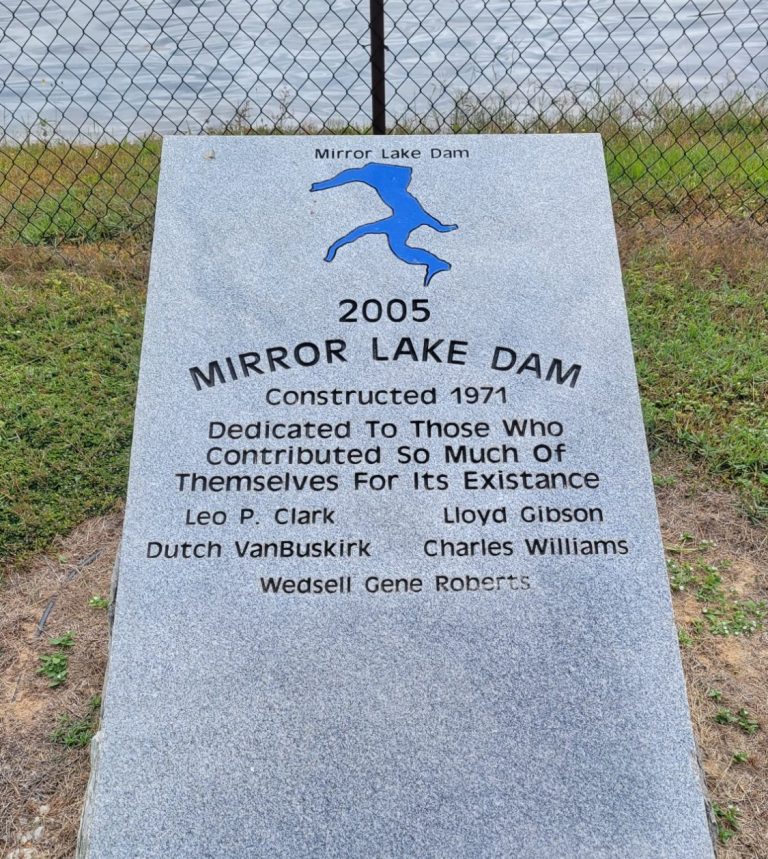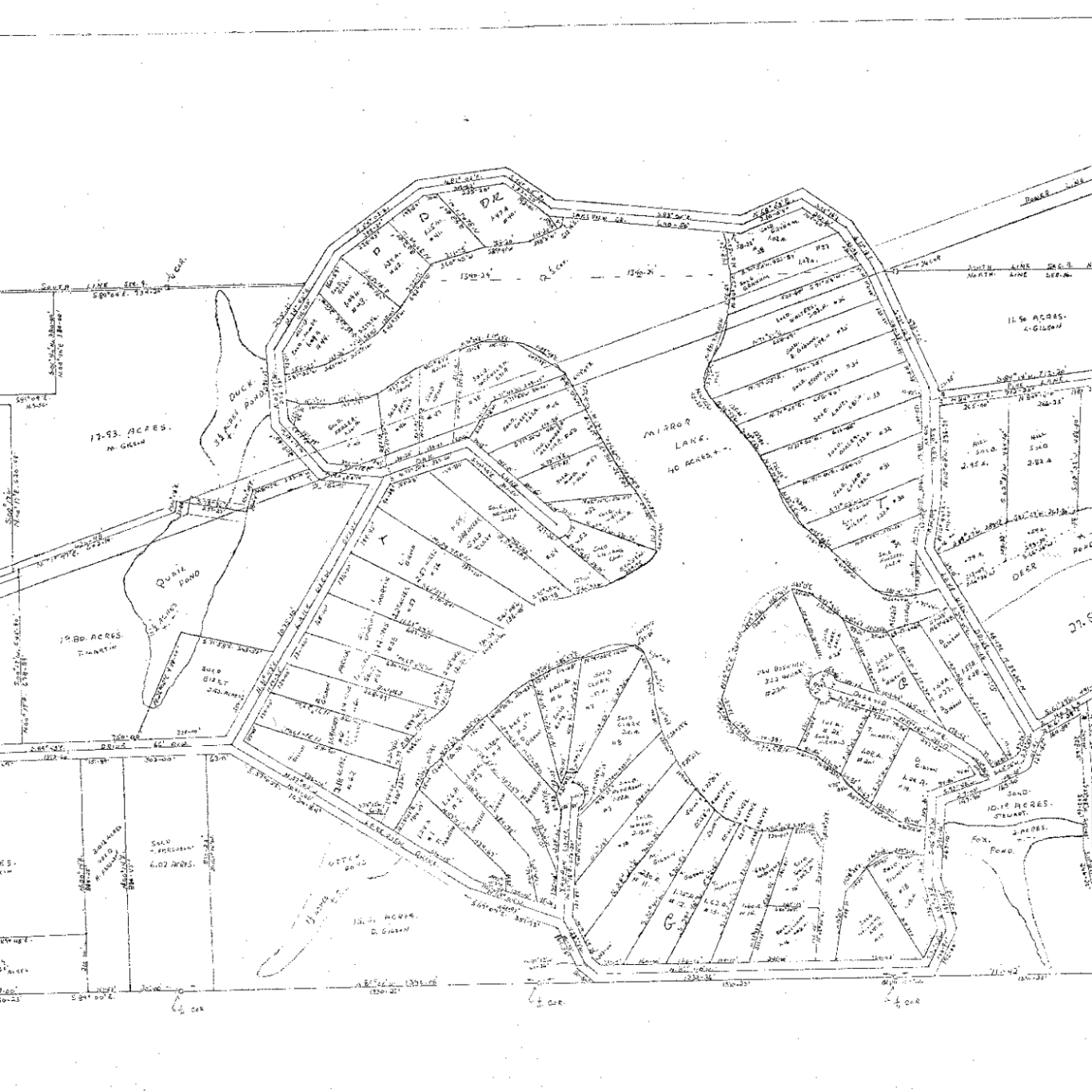About
Mirror Lake is located east of Crestview, Florida.

History of Mirror Lake
Mirror Lake was developed in 1971 by Lloyd Gibson out of his vision for tranquil country living in the beauty of Northwest Florida. As time passed, Mirror Lake was discovered and our community grew. Mirror Lake was originally developed as the “Lakewood Country Estates” subdivision, but the development was never officially recorded.
In 1987, a hole rusted into the dam spillway pipe causing Mirror Lake to drain down to a few-acre swamp. The spillway was plugged with concrete and the spillway pipe was left in place. The spillway pipe was not removed due to the already challenging cost of repairing the dam even without additional excavation and rebuild to remove and replace the pipe. The small number of owners at that time were limited in ability to fund major projects.
After the dam was repaired, a siphon system was installed to control the lake level as the original spillway no longer worked. The siphon system worked poorly and required constant manual restarting of the siphon flow when the lake level rose. The siphon system would allow a two-foot rise in the lake level if someone did not manually start the siphon flow after a big rain.


In 1996 Mirror Lake was losing water. Inspection of the old spillway and pipe revealed a new rust hole past the concrete plug. Out of necessity, the old spillway and pipe were removed and replaced. Unfortunately, the new corrugated pipe used for the spillway ultimately proved to be poorly engineered. The contractor, Billy Steele, pointed out the new pipe was being buried 33 feet deep versus the pipe manufacturer’s specified maximum depth of 12 feet. The corrugated pipe was rolled and not continuously seam welded. The pipe wall thickness was only .079 inch. The pipe company claimed it would last “100 years”. The civil engineer hired to oversee the dam repair, and the engineers from Northwest Florida Water Management District (NWFWMD), disagreed with Steele and forced him to proceed with the corrugated pipe.
September 1998 brought Hurricane Georges and 30 inches of rain. It became an all hands on deck among the owners to save the dam following the storm. The last section of the corrugated pipe blew out, causing massive erosion on the dam’s North face and threatening the integrity of the entire dam. Rubble was dumped on the dam as an emergency erosion measure. The failed section of corrugated pipe was dug up and replaced. The dam seemed stable after the pipe repair.
In March 2001, people noticed the spillway discharge water was discolored like it was possibly carrying dirt and clay from inside the dam. The back (North) side face of the dam was found to be saturated and on the edge of breaking loose and landsliding. The old siphon system was put back in emergency service and the lake level was lowered barely in time to prevent the dam completely washing out. A large amount of dirt had caved off the dam’s North face and washed downstream. The consensus was the corrugated spillway pipe had somehow failed. This was confirmed with Marvon Newby taking video that confirmed the pipe had completely collapsed. It was thought the burial depth of the pipe and the traffic across the dam contributed to the pipe collapse. The MLOA retained a lawyer to determine if any of the repair cost could be recovered. That lawyer consulted with three civil engineers out of Pensacola, who estimated the dam repair at $350,000 plus dredging of the dam material that washed downstream. They also estimated it would take 19 months to complete the dam repair.
Gene Roberts began investigating dam failures and spillway issues in other Northwest Florida lakes with earthen dams, focusing on lakes built by Steele. Of fifty lakes built by Steele, three other dam failures were found in addition to the Mirror Lake dam. All four dam failures had used the same civil engineer and pipe supply company as Mirror Lake. There were no failures in the 46 dams built by Steele that did not use the Mirror Lake civil engineer or pipe supplier.
The MLOA lawyer felt a case against the civil engineer and the pipe company was winnable but would be expensive and drawn out. The lawyer also thought it was hopeless to win against the NWFWMD engineers that forced using the corrugated pipe and burying the pipe deeper than the pipe manufacturer specified. Right about then the pipe company filed for bankruptcy, and the civil engineer was found to not have any professional liability insurance. The idea to sue was dropped.
So a busy time of MLOA self-help began. As a personal favor to Mirror Lake owners he had befriended, Steele offered use of his equipment at cost with the owners providing labor. As usual, a plague of ‘experts’ descended with all of them wanting to be paid for their not very useful opinion. Soil compaction tests, X-ray of pipe welds, etc. requested by NWFWMD looked easily capable of getting the repair cost up to and maybe exceeding the $350,000 estimate. Fortunately, some common sense got involved and ways to address the various demands of NWFWMD were negotiated. Typical of working through the challenges, demands for 80+ soil density tests were reduced to just four tests which were all that was actually needed.
Thick wall (.75”) gas pipe the MLOA bought out of Missouri was planned to replace the failed corrugated pipe. Four forty-foot sections were purchased for $5,000 giving 160 total feet of pipe. Two 80-foot sections would be made up on the ground, lowered into the dam, and buried after welding at the center to complete the 160-foot pipe run through the dam. Welding the pipe was hopeless with the weld puddle blowing out and the metals separating. NWFWMD concern for using the gas pipe skyrocketed based on the welding issues. After talking with oilfield pipe welders, it was discovered the pipe had become magnetized from materials flowing through it in a single direction when the pipe was in gas service. The pipe would have to be shipped to Atlanta for demagnetization at a cost of several thousand dollars. So here comes Gene with a refrigerator magnet after he thought about the problem over coffee. Using that magnet, he identified the North and South magnetic poles of the pipe sections. When the pipe sections were arranged with the ends attractive as North-South, the welding proceeded with no issues.
Still suspicious of the welding, NWFWMD demanded the welds receive very expensive X-ray inspection. Steele stated he could prove the welds were good without X-rays. The NWFWMD engineer had that ‘yeah right’ look but allowed him to give it a go. He lifted the 80-foot welded sections with an excavator and dropped them 15 feet to the ground several times. The welds held steady and the NWFWMD engineer signed off while shaking his head at common sense testing. Roughly a thousand yards of downstream wash dirt from the dam was recovered and re-used in the dam repair.
Traffic over the dam was believed to contribute to the spillway pipe collapse. That and vehicle damage causing erosion were the primary reasons to close the road over the dam after obtaining county approval to do so. 22 yards of concrete around the pipe joints, two anti-seep collars, and 150 truckloads of red clay completed the spillway pipe replacement and dam repair.
The final cost of the MLOA self-help repair of the dam was just under $30,000. The successful repair of the dam for less than a tenth of the initial estimate shows what a group of focused people working together and a dose of common sense can accomplish.
Mirror Lake
Original Survey Plat by Developer Lloyd Gibson

Photos by JClark
We need your consent to load the translations
We use a third-party service to translate the website content that may collect data about your activity. Please review the details in the privacy policy and accept the service to view the translations.

